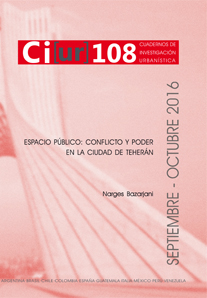Espacio público: conflicto y poder en la ciudad de Teherán
DOI:
https://doi.org/10.20868/ciur.2016.108.3455Palabras clave:
Poder / Espacio público, Género, Efímero, Rebeldía, Clandestinidad, Power, Public space, Gender, Ephemeral, rebellion, ClandestinityResumen
En una ciudad gobernada por una ideología dominante, el espacio público se convierte en el espacio de la representación y el ejercicio del poder. El poder intenta visualizar su ideología presentando una imagen falseada del ciudadano. Cuando el poder es patriarcal, el cuerpo de la mujer se convierte en un arma para mostrar la omnipresencia de la ideología dominante. La mujer responde con su desobediencia, la cual contagia a parte de sus conciudadanos. Pero ante su impotencia para recuperar el espacio público, la sociedad busca su salida en la creación de otros espacios. En este trabajo se investiga cómo son esos otros espacios en Teherán.
Abstract:
In a city governed by ideological powers, the images of citizens in public spaces are fabricated to impose the ideology. When this ideology is patriarchal, the appearance of women in public spaces is an influential icon used by the power to be omnipresent. When such image is not matched with women’s desired appearance in public places, they react. The reaction causes a conflict, which spread through other citizens sharing the public space. The conflict leads citizens’ to create some parallel public spaces, where they can represent themselves as they desire. Tehran is a good example of such a city. The objective of this paper is to investigate how these parallel spaces are created.
Descargas
Referencias
AFARY, J. & B. ANDERSON, K. (2005) Foucault and the Iranian revolution. Chicago: The University of Chicago.
AGAMBEN, G. (2003) Estado de excepción. Buenos Aires: Adriana Hidalgo.
ARENDT, H. (1961) Between Past andFuture. New York: Viking.
AUGE, M. (1993) Los no lugares. Espacios del anonimato. Antropología sobre la modernidad. Barcelona: Gedisa.
BALASESCU, A. (2007) Paris Chic, Tehran Thrills, Aesthetic Bodies, Political Subjects. Electronic Edition, ZETA https://doi.org/10.7761/9789738798021
BOZORGIAN, A. (2011) Delighted resistance, onlineedition, Radio Zamaneh.
CALVINO, I. (1998) Las ciudades invisibles. Madrid: Siruela.
DEHAENE, M. & DE CAUTER, L. (eds.), (2008) Heterotopia and the City. London: Routledge.
FLORENSKY, P. (1920) La Perspectiva Invertida. Madrid: Siruela.
FOUCAULT, M. (1967) Of Other Spaces, Heterotopias, Architecture, Mouvement, Continuité. London: Routledge.
HABERMAS, J. (1962) The Structural Transformation of the Public Sphere. Massachusetts: MIT Press.
HABERMAS, J. (1981) Ensayos plíticos. Barcelona: Peninsula.
HONNETH, A. (1992) La lucha por el reconocimiento. Barcelona: CRÍTICA.
HUIZINGA, J. (1972) Homo Ludens. Madrid: Alianza.
KATUZIYAN, H. (2003) Iranian History and Politics, the Dialectic of State and Society. London: Routledge.
KATUZIYAN, H. (2001) State and Society in Iran: The Eclipse of the Qajars and the Emergence of the Pahlavis. Tehran: Nashr-e Markaz.
KUNDERA, M. (1978) El libro de la risa y el olvido. Barcelona: Seix Barral.
LEFEBVRE H. (1974) La producción del espacio. Madrid: Capitán Swing Libros S.L.
LEFEBVRE H. (1968) El derecho a la ciudad. Barcelona: Edicions 62.
LONGERICH, P. (2010) Himmler. Paris: Heloise d’Ormesson.
LOWER, W. (2013) Hitler's Furies: German Women in the Nazi Killing Fields. Boston: Houghton Mifflin Harcourt.
MASSEY, D. (2005) For space. London: SAGE Publications Ltd.
MASSEY, D. (1994) Space, Place and Gender. Minneapolis: University of Minnesota Press.
MIÉVILLE, C. (2008) UnLunDun, by China Miéville. London: Del Rey Books.
NIETZSCHE, F. (1883–1885) Así habló Zaratustra. German: Ernst Schmeitzner.
PERRAULT, CH. (1697), Sleeping Beauty in the Wood.
SCHLÖGEL, K. (2003) En el espacio leemos el tiempo: sobre historia de la civilización y geopolítica. Madrid: Siruela.
THRIFT, N. & MAY, J. (eds.) (2001) Timespace: Geographies of Temporality. London: Routledge.












